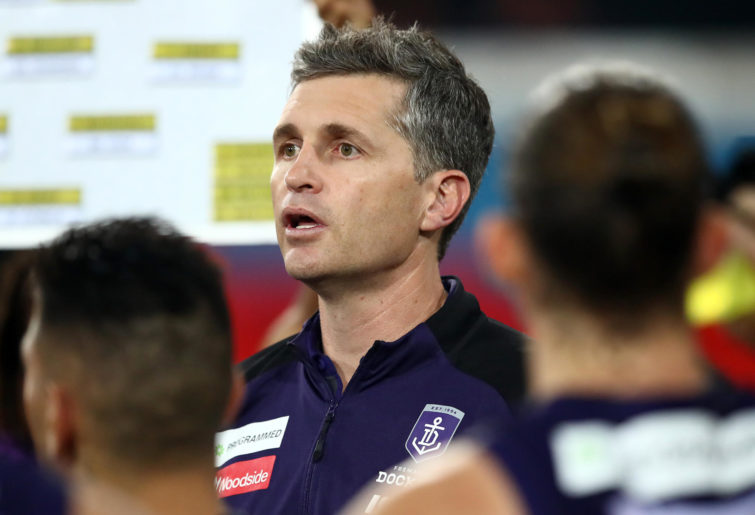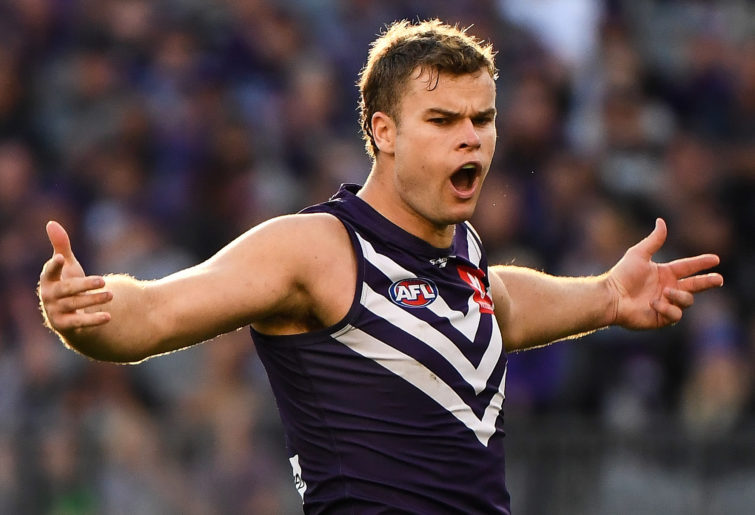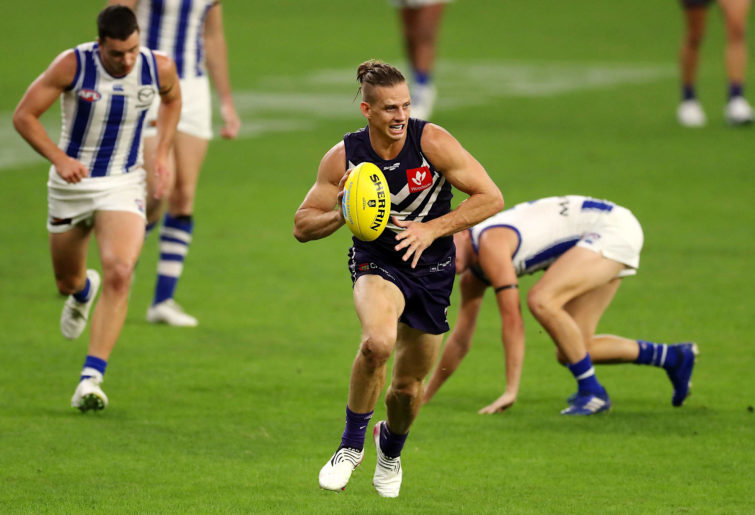Imagine the Fremantle Dockers sitting inside the top four come their Round 14 bye.
For years, the great hopes of the purple army have come from their impressive AFLW team but 2022 looks like the year the men catch up.
There has been reason to be bullish about the Fremantle over the past couple of seasons. The list is being built intelligently and Justin Longmuir’s ability to remain level-headed and his systematic approach to tactical configuration has really given the Dockers a fresh start in their eventual quest for greatness.
Despite facing significant injuries since taking over, Longmuir’s desire for stability remained untouched and set the standard for his club.
Truly a modern-day coach, the 41-year-old’s approach to his first two years in charge has been refreshingly educational and intentionally different in each season.

(Photo by Jono Searle/AFL Photos/via Getty Images )
In 2020, the Dockers conceded the fifth fewest points and Brennan Cox was discovered as a genuinely strong and still underrated key defender.
Luke Ryan played a role far bigger than he is and Longmuir made a clear judgement call on utilising medium defenders to fill in parts of the defensive structure he wanted to keep in place.
The way Fremantle set up tactic-first, rather than trying to cater directly to the available personnel, was eerily reminiscent of the formative years of the Richmond era, and even the Demons last season.
2021 flipped things around, when the pure focus was getting efficiency in ball movement and transition, speeding things up and becoming a quicker team overall.
Surface-level numbers only indicate that the Dockers went from being ranked 16th to 15th for points scored, but in reality, it was the team’s inefficiency in front of goal that was most restrictive, rather than the shift in tactical focus.
Fremantle actually went from having the least scoring shots per game to having the tenth most and from 17th to ninth in inside 50s. In 2020 they scored from 36.36 per cent of their inside 50s. In 2021, that increased to 43.24 per cent.
As the likes of Sean Darcy, Caleb Serong and Andrew Brayshaw took strides forward in the midfield to join David Mundy and the oft-unavailable Nat Fyfe, Fremantle went from being ranked 14th to seventh in clearances.

(Photo by Daniel Carson/AFL Photos via Getty Images)
The significant increase in uncontested marks coincided with them wanting to use both back and forward flankers to find space through the middle and create better opportunities for their forwards by leaving open pockets behind them.
Defensively, they dropped to conceding the seventh most points.
Even league-average goal kicking would’ve won the Dockers their Rounds 9 and 16 clashes against Essendon and Carlton, which would’ve allowed them to make finals, but the reality of the situation is that the team was never ready.
If you believe Justin Longmuir is a genuinely good, young coach, then you’ll also believe in the deliberate structuring of these two seasons for educational purposes for the Dockers, culminating in the combination of both heading into his third season in charge.
Historically, this team has been the most enigmatic in the competition.
Inconsistent and unreliable are unfortunate tags that needs to be shaken.
Yet things look far rosier to kick off 2022 for the Dockers, which only adds fuel to the argument of a hot start.
The injury list looks far friendlier this year than either of the past two years that Longmuir has been in charge of.
Managing the injury-prone bodies of Nat Fyfe, Alex Pearce and Matt Taberner has been the priority and protecting the team’s lynchpins has only acted as a way to help improve the depth and confidence of players on the periphery.

(Photo by Paul Kane/Getty Images)
Pre-season practice matches are hardly the be all and end all, but against the utterly shambolic Eagles, who don’t look like figuring anything out this season, Fremantle played faster footy than ever, were stronger in the clinches and had a defensive unit that had good coverage, despite the team being undermanned.
It was the first time we were able to see a combination of the 2020 and 2021 styles of play and it looked incredibly dangerous.
Again, it felt as though Longmuir was filling his tactical template with the players at his disposal rather than trying to get too cute, like recent premiers.
All things being equal, the Dockers have their fair share of home fixtures before the bye.
They play four of their first six games at Optus Stadium, extending to eight games until their break. They finished last season with a record of seven wins and four losses at that ground.
Of their eight ‘home’ opponents in this period of time, only Brisbane and GWS were finalists last season and they will take on Adelaide and Gold Coast in their travelling games.
The toughest games will clearly be Geelong in Geelong, the Demons in Melbourne and hosting the Lions, but all other games seem winnable.
The potential of Fremantle’s identity is what is most alluring. And before the season, it has them rated as better than even chances in contests against Essendon, GWS, St Kilda and Carlton.
Nine wins have been the mark over the past four seasons for being in the top four after 13 games. The flow-on effect is that these teams have finished the season in the top eight.
Which ultimately begs the very basic question, can the Dockers make the finals in 2022?
If they experience a season with a normal number of injuries to key personnel, there is little doubt the Dockers can cause some serious damage.

(Photo by Daniel Carson/AFL Photos via Getty Images)
The key defensive stocks are good and the rebounding line has quickly turned into one of the league’s most potent.
Justin Longmuir has already discussed difficulties in trying to narrow 11 players down to seven defensive spots but any combination will see a combination of strength, above average intercepting and elite ball use out of the defensive half.
Hayden Young, in particular, is the player worth following most as the main conduit between winning the ball back defensively and carving up the opposition by foot.
Midfield depth isn’t an issue at Fremantle with the number of comfortable inside midfielders and the outside coverage fulfilled by hard-running flankers and skilled users who can play in advanced roles.
Many scoffed at Champion Data’s labelling of Sam Switkowski as elite, but when he played full games, the 25-year-old was the clear leader for Fremantle in terms of score involvements, was the best tackler out of the forward-half players and covered the ground manically, often pushing up to around the contest.
The over-reliance on the injury-prone Matt Taberner is the biggest sticking point for the Dockers should no one provide adequate support and he can’t complete a full season.
Michael Walters has already been earmarked for a role much closer to goal, which is handy given he has won the club’s goal kicking award five times, and Nat Fyfe will spend plenty of time in attack, while speedier ball movement inevitably creates more chaos, lending itself to more goal-scoring opportunities for those who demand lesser defenders.

(Photo by Will Russell/AFL Photos via Getty Images)
And finally, the biggest indicator of a team ready to take the next step is its depth and whether they have 28-30 players who can fill in the outlined roles adequately at a moment’s notice.
If you consider the likes of Heath Chapman, Michael Frederick, Will Brodie, James Aish, Nathan Wilson, Joel Hamling and the prodigiously talented Sam Sturt as players fighting for spots in the best 22 just to name a few, then you’ll soon realise that a full-strength Fremantle outfit runs deeper than most teams. There are at least five other players and recent draftees Nathan O’Driscoll and Neil Erasmus who fall in the same category.
Understandably, some will remain sceptical of the enigmatic Dockers and will want more evidence before buying in.
Even a 4-0 start may not appease some, and that would have included wins against St Kilda and GWS.
But if this team plays as quickly and as dangerously as they have with the defensive structures of 2020 in place, then we’re not just looking at a finals team.
The Fremantle Dockers would be looking at their competitors from above come their Round 14 bye firmly entrenched in the top four, and on their way to greener pastures come September.

































































































